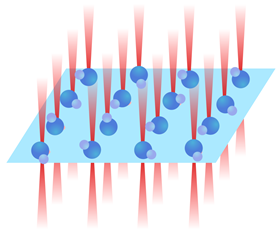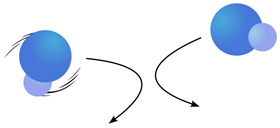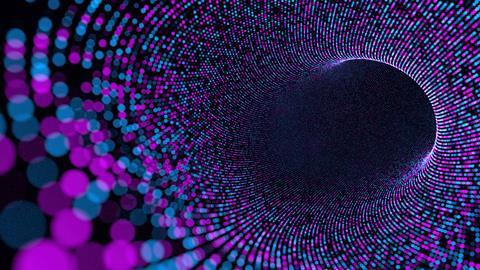If you put ultracold molecules into different quantum states, you can load optical tweezers much more efficiently. According to researchers in Nijmegen, this brings the quantum computer a step closer.
In order to better understand complex matter and problems, researchers do not only want to use models, but also seek quantitative solutions with mathematics. You can do a lot on supercomputers, but at some point you reach the limits of their computing power. ‘Many complex problems in physics are based on quantum mechanics’, says Etienne Walraven, a PhD student at Radboud University Nijmegen. ‘So it would be a logical step to use quantum computers for such problems, since they are based on the same principles.’
Flavours
Although the quantum computer itself is still a long way off, researchers are working hard to advance the field. ‘There are many flavours of quantum computers’, explains Walraven, ‘but one possibility is to build a grid of atoms or molecules.’ At the moment, the field has yet to find the efficiency to build and load such a grid. ‘Once we can do that, you could start doing quantum computing.’ Walraven and his supervisor Tijs Karman used computational chemistry to work out how to fill such a grid properly, and published their results in Physical Review A and in Physical Review Letters.

‘You make a grid with something called an optical tweezer’, says Walraven. ‘This is a laser that you divide several times into very many smaller lasers, each of which you can move individually.’ Atoms and molecules feel a certain attraction to these lasers and move into them, but in theory this results in a grid that is only fifty per cent randomly filled, which in practice is even less. ‘You need a full grid if you want to do anything, so you have to move all these lasers around manually to put all the molecules next to each other, and that takes a lot of time.’
Limit
Another disadvantage is that the molecules will eventually break down due to collisions with other molecules and their finite lifespan. Walraven: ‘So there is a limit to how big you can make the grid. The field would be greatly advanced if it could be done more efficiently.’ Many research groups are therefore trying to speed up the ‘sorting process’ by improving the algorithms around these lasers, but Walraven and Karman approached the problem from a different angle.
‘We had been working on a more efficient way of filling optical tweezers for almost two years, but we had not been successful despite several proposals’, recounts Walraven. ‘When I returned from my summer holidays last year, Tijs said he had seen something extraordinary. By putting our molecules in different rotational states, they didn’t destroy each other when they collided. We were astonished that we couldn’t find this in the literature, so I started to look into it in more detail.’

If you make molecules extremely cold – think a few billionths of a degree above absolute zero – then quantum mechanics prevails. You can then use microwave radiation to push the molecules into a particular quantum state, for example a particular rotation. ‘It is partially known what happens when molecules in these states bump into each other’, says Walraven. ‘If they are in the same state, they have Vanderwaals interactions. If two molecules are in a different state, they have an even stronger attraction through dipole-dipole interactions. This attraction also causes them to jump out of the grid. But if you make the difference bigger, two quanta, they suddenly repel each other!’
Hope
This repulsive interaction ensures that a molecule that ends up in the grid of the optical tweezers remains stable when a molecule in a different quantum state collides with it. Walraven: ‘You can go in a number of directions with this discovery, because these are really new, stable interactions. One of the applications is to fill tweezers more efficiently. In our other paper, we show that we can increase the theoretical filling efficiency from fifty to eighty percent. We really don’t understand why nobody else has looked at this. It feels like a textbook idea, something that should have been known a long time ago.’
Although this work was purely theoretical, there certainly is hope for applications. ‘Together with Michael Tarbutt from Imperial College London, we looked at whether our theoretical method would be feasible in practice, and he was also positive,’ says Walraven. ‘Now the hope is that experimenters will pick this up and more people will try to fill these grids.’ The quantum computer is getting closer and closer.
Walraven, E.F., Tarbutt, M.R. and Karman, T. (2024) Phys. Rev. Lett. 132(18), DOI: 10.1103/PhysRevLett.132.1834
Walraven, E.F. and Karman, T. (2024) Phys. Rev. A 109(4), DOI: 10.1103/PhysRevA.109.043310













Nog geen opmerkingen